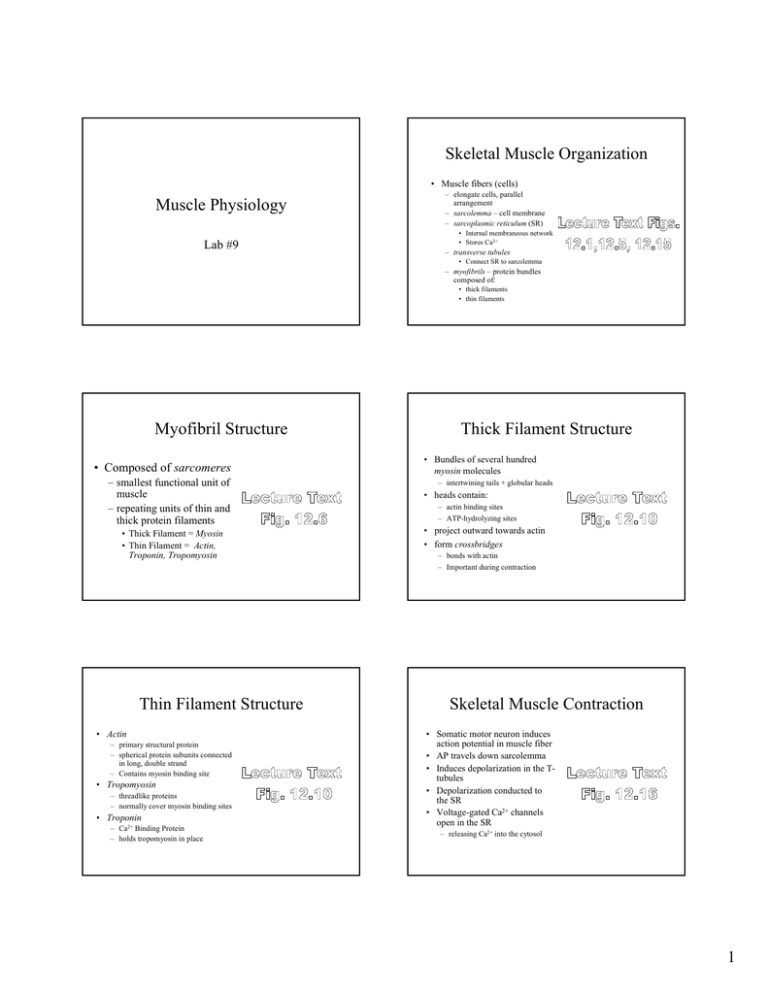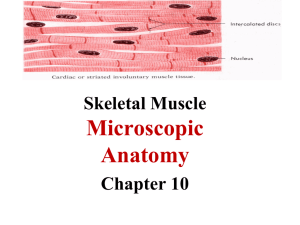Muscle Physiology Skeletal Muscle Organization Myofibril Structure
advertisement

Skeletal Muscle Organization • Muscle fibers (cells) Muscle Physiology Lab #9 – elongate cells, parallel arrangement – sarcolemma – cell membrane – sarcoplasmic reticulum (SR) • Internal membraneous network • Stores Ca2+ – transverse tubules • Connect SR to sarcolemma – myofibrils – protein bundles composed of: • thick filaments • thin filaments Myofibril Structure • Composed of sarcomeres – smallest functional unit of muscle – repeating units of thin and thick protein filaments • Thick Filament = Myosin • Thin Filament = Actin, Troponin, Tropomyosin Thin Filament Structure • Actin – primary structural protein – spherical protein subunits connected in long, double strand – Contains myosin binding site • Tropomyosin – threadlike proteins – normally cover myosin binding sites • Troponin – Ca2+ Binding Protein – holds tropomyosin in place Thick Filament Structure • Bundles of several hundred myosin molecules – intertwining tails + globular heads • heads contain: – actin binding sites – ATP-hydrolyzing sites • project outward towards actin • form crossbridges – bonds with actin – Important during contraction Skeletal Muscle Contraction • Somatic motor neuron induces action potential in muscle fiber • AP travels down sarcolemma • Induces depolarization in the Ttubules • Depolarization conducted to the SR • Voltage-gated Ca2+ channels open in the SR – releasing Ca2+ into the cytosol 1 Skeletal Muscle Contraction • Ca2+ binds to troponin • Troponin undergoes shape change – pulls on tropomyosin • tropomyosin shifts position – uncovers myosin binding sites on the actin filaments Skeletal Muscle Contraction • Movement of thin filaments over thick • sarcomere shortening • length of the filaments do not change All or None • Individual muscle fibers respond to a single stimulus in an all or none fashion – undergo action potential – action potential triggers contraction – subthreshold stimulus = no contraction – superthreshold stimulus = maximal contraction Skeletal Muscle Contraction • myosin head binds to actin • crossbridge bends – power stroke – pulls thin filaments toward center of the sarcomere • crossbridge link breaks • myosin head returns to original configuration • binds to next actin molecule Muscle Relaxation • Ca2+ pumped back into the SR by active carriermediated transport – troponin releases Ca2+ – tropomyosin covers myosin binding sites on the actin molecules • Membrane-bound enzyme (acetylcholinesterase) – breaks down ACh released at the NMJ Motor Units • Multiple muscle fibers are enervated by a single motor neuron • Motor Unit – motor neuron + all muscle fibers it innervates – muscle fibers in a motor unit contract as a single unit 2 Motor Unit Recruitment • Individual motor units contract in an all-or-none fashion • Differences in contractile strength are due to differences in the number of contracting motor units • Motor Unit Recruitment – increasing the number of contracting motor units to increase the overall strength of contraction Twitch Properties • • • Latent Period – Time btw AP production and development of tension. – Excitation-contraction coupling Contraction Time – Time btw beginning of contraction and peak tension – Shortening of muscle Relaxation Time – Time btw peak tension and return to resting tension – Ca2+ re-uptake and stretching of muscle back to resting length Muscle Mechanics • Twitch – single contraction and relaxation of muscle in response to a single action potential • Tetany (Tetanus) – sustained tension exerted by a muscle due to continuous contraction Temporal Summation • AP duration much shorter than contraction duration – several APs can occur in a muscle fiber during the course of a contraction Muscle contraction Action potentials • Multiple APs can have a summation effect on tension generation Latent Period Contraction Time – induce release of Ca2+ from SR before muscle is fully relaxed – increase tension Relaxation Time Tetany • High rate of AP generation in fibers • no time for muscle to relax • sustained level of tension Experiments: Frog gastrocnemius recordings • Follow instructions in manual CAREFULLY!!! – Threshold – Recruitment in muscle organs – Twitch time measures • Latent period, contraction time, relaxation time – Repeated stimulation and stimulus frequency 3 Electromyograms (EMGs) • Muscles undergo action potentials • Electrical signals conducted through body fluids • Can be measured from the surface of the body • EMGs can indicate muscle activity Types of Muscle Contractions • Isotonic Contractions – Muscle shortens in length – Generated same strength for a given load throughout the contraction process • Isometric Contractions – Muscle does not shorten, remains at the same length – Load = strength of contraction Experiment: EMGs • Motor unit recruitment on forearm • Isotonic vs. Isometric contractions 4







